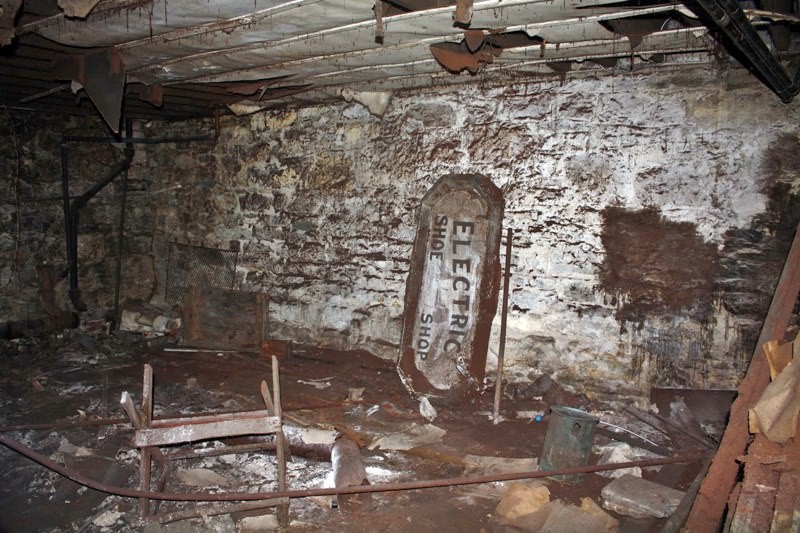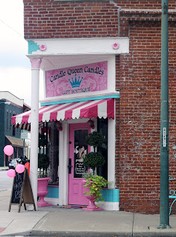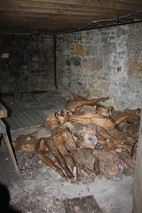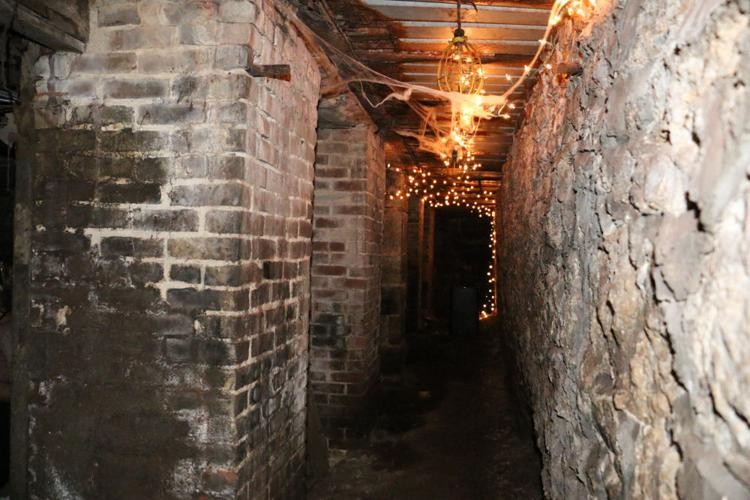The Tunnel Remains
Introduction
Text-to-speech Audio
Under this small candle shop in Leavenworth, KS, lies a mysterious tunnel dating as far back as 200 years. While the city of Leavenworth has filled in the other tunnels for construction, the tunnel underneath Candle Queen Candles is one of the only two remaining. It only becomes more mysterious as the remains of mannequins, shop signs, sawdust, and various other artifacts were found within it. However, even with these discoveries, many are still unable to tell the true purpose of this historic tunnel. Though, its theories range from it being used as an underground railroad to even an underground city. So, to dive into these speculations we must revisit the history of the small town of Leavenworth, KS.
Images
One of the stores that contains a sign "Electric Shoe Store", revealing its potential use

Candle Queen Candles store in 2015

Mannequins found underground within one of the stores in the underground city

The broader view of the tunnel with lights placed by the Candle Queen Candles used during tours

Backstory and Context
Text-to-speech Audio
Within Leavenworth, KS, a saloon was built in 1858, which would later become Candle Queens Candle in 2008. Also built around the late 1850s, was a hidden tunnel underneath this saloon speculated, in an interview, to be a part of the Underground Railroad at the time. This was a significant time because within the late 1850s, Leavenworth became a free state. Kansas in general was known to have the Underground Railroad range from various places like Lawrence to Leavenworth to Topeka and more. Ultimately, with Leavenworth being at the border of Kansas and Missouri (a heavily proslavery state), it basically made Leavenworth a hotspot for slaves on their route to freedom. For example, in the Freedom Crucible, one of the many narratives focuses on how a family takes a passage using wagons, underground railroad stations, and boats to pass from Missouri to Leavenworth and to Lawrence for freedom. This fuels the speculation that this tunnel, conveniently hidden under a saloon with narrow passageways throughout the town, could’ve been used by slaves on their route to freedom. However, there is no pinpoint evidence of whether the Underground Railroad incorporated these tunnels, and therefore, this speculation only remains a theory.
But what does the underground railroad have to do with mannequins, shop signs, and sawdust? Another theory of this tunnel is its use as an underground city. While freed slaves were allowed to be within the state of Kansas, racism didn’t simply go away. During segregation in Leavenworth, Black individuals were forced to live in designated areas, go to school on the bottom floors of buildings, attend separate churches, and more. Many white individuals refused to shop within the same shops as Black individuals and, therefore, it was speculated in an interview by the owner of Candle Queen Candles that this underground city was used as an underground city for Black individuals to shop. This tunnel was found to have remains of shop signs stating, “Electric Shoe Shop”, several storefronts, and even sawdust dating back to 150 years from a woodworker. So, using the context of that period paired with these remains found, it fuels the theory that the tunnel could’ve been used by the Black community as a safe space to shop. However, with the lack of evidence, this speculation also remains as just another theory. But there’s more.
Yet another theory is the usage of the tunnel as a hidden passageway for bootleggers during Prohibition. Around 1919 and 1933, the 18th amendment was passed which prohibited the manufacture, sale, and possession of alcohol. As there was a prominence of bootleggers and illegal sellers of alcohol in Kansas, they would use speakeasies, saloons, and other secretive areas to sell and consume illegal beverages. Leavenworth residents, as Rowe reveals, also contributed their fair share of rebellion of this amendment, for example, by distributing alcohol within milk bottles. Therefore, another speculated use of this tunnel was for bootlegging alcohol as it provided the secrecy needed for the transportation of alcohol and the avoidance of police. Yet again, without any firm evidence found, this speculation also remains as one of the many theories about this tunnel.
Even without knowing the true builder(s) or purpose of this tunnel, these strong speculations alone create layers of history on its own. Not to mention how much the missing pieces, like the filled in tunnels or artifacts eradicated over time, can tell us about history and society. Within the 1800s, these tunnels stretched all throughout Leavenworth and possibly held more artifacts to help unravel the complex history of Leavenworth. However, with new construction done throughout the town, they were later filled in by the city. So, while it’s unclear of the true purpose of this tunnel, we can use the remains and historical context to help theorize what truly took place under what is now Candle Queen Candles and tell a new layer of the history of Leavenworth, KS.
Sources
Allyson. “Queen Supreme: The Candle Kitchen and Tunnel Tour with Leavenworth's Candle Queen.” Queen Supreme: The Candle Kitchen and Tunnel Tour with Leavenworth's Candle Queen, 9 Sept. 2015, http://magnoliasandmimosas.blogspot.com/2015/09/queen-supreme-candle-kitchen-and-tunnel.html. - Blog that gives an online walk-through/tour of the tunnel
Woods, Randall B. “Integration, Exclusion, or Segregation? The ‘Color Line’ in Kansas, 1878-1900.” JSTOR, Oxford University Press, 1983, https://www.jstor.org/subjects. - Article telling the history of Leavenworth segregation
Goodman, Kevin, et al. PlainSpirits. KTWU, 2021, https://watch.ktwu.org/video/plainspirits-1ftuel/. Accessed 1 Nov. 2022. – Show that holds an interview with Candle Queen Candles owner
Rowe, Elfriede Fischer. “Wonderful Old Lawrence.” Liquor in the Prohibition Era, 10 Jan. 1968, http://www.kancoll.org/books/rowe/liquor.htm. - History of Prohibition within Kansas
Sheridan, Richard B. Freedom's Crucible: The Underground Railroad in Lawrence and Douglas County, Kansas, 1854-1865: A Reader. Division of Continuing Education The University of Kansas, 1998. - Book holding various narratives about using the Underground Railroad
https://www.orangesmile.com/extreme/en/underground-cities/leavenworth.htm.
http://magnoliasandmimosas.blogspot.com/2015/09/queen-supreme-candle-kitchen-and-tunnel.html.
http://magnoliasandmimosas.blogspot.com/2015/09/queen-supreme-candle-kitchen-and-tunnel.html.
